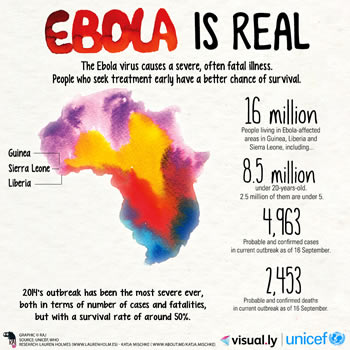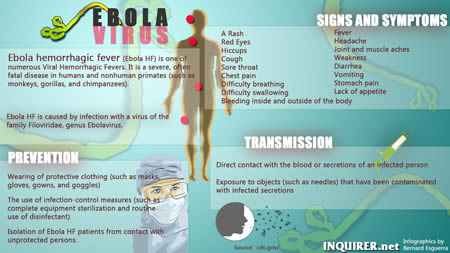All about Ebola Virus
Summary: Ebola is a deadly virus that originated in Africa. The 2014 West Africa outbreak has resulted in 13,042 reported cases and 4,818 deaths as of 5 November 2014. Once infected, the person will start to show symptoms between 2 to 21 days. The initial symptoms of Ebola may include fever, sore throat, and headaches. The person may also feel fatigued and experience pain in the muscles and joints. There is no cure of Ebola, neither is there is a vaccine to prevent the spread of it.

Ebola is one of the diseases that cause a hemorrhaging fever in its patients. It is a deadly virus that originated in Africa. While its frequency of outbreak is low, it can create havoc and a wide-spread epidemic, as witnessed by the 2014 Ebola outbreak in West Africa. The 2014 outbreak has resulted in 13,042 reported cases and 4,818 deaths as of 5 November 2014. Prior to this outbreak, Ebola had caused a total of 1,716 cases over the course of 24 outbreaks since its discovery in 1976.
One cannot contract the disease too easily; hence, a person who has not come into direct contact with an infected person is not at risk for it. However, if a person does contract Ebola, the chances of that person dying from it are between 25% and 90%. The only way that a person can contract Ebola is by coming into direct contact with the blood or other bodily fluids of an infected person. These can include saliva, mucus, vomit, feces, sweat, tears, breast milk, urine and semen. The virus present in these must then enter the non-infected person’s body through mucous membranes such as nose, mouth, eyes, open wounds, cuts and abrasions. The virus can also enter the body via the used of contaminated needles.
Once infected, the person will start to show symptoms between 2 to 21 days, the average being 6 to 8 days. These symptoms might be very similar to other diseases, such as malaria, cholera, typhoid fever, meningitis and other viral hemorrhagic fevers, which makes the disease harder to diagnose. A person infected with Ebola cannot spread the disease until he starts to exhibit the symptoms, and if he does not exhibit any symptoms until 21 days, then he is Ebola free.
The initial symptoms of Ebola may include fever, sore throat, and headaches. The person may also feel fatigued and experience pain in the muscles and joints. This is often followed by vomiting, diarrhea and abdominal pain. After this, the patient may also experience shortness of breath and chest pain, as well as swelling, headaches and confusion. About 50% of the patients also develop a maculopapular rash, i.e. small bumps on a flat red area of skin.
This is then followed by internal and external bleeding, including vomiting of blood, coughing up of blood or blood in stool. It is likely that death may follow between 6 and 16 days after the start of the symptoms, and will probably be preceded by a coma. There are also chances that the patient may recover, and in the case of recovery the patient may start to feel better between 7 and 14 days after the start of symptoms. Even after recovery, the patient may suffer ongoing muscle and joint pain, liver inflammation, and decreased hearing among other difficulties. However, after the patient starts exhibiting bleeding, the chances of recovery are reduced.
 In order to diagnose a person, health officials will take a look at the symptoms, the patient’s travel and work history, and see whether or not that person may have some into contact with someone who may be infected, or with some wildlife from which he could have contracted the virus. In addition, they will also conduct a blood test to check for a low platelet count, an initially decreased white blood cell count followed by an increased white blood cell count, as well as elevated levels of the liver enzymes alanine aminotransferase (ALT) and aspartate aminotransferase (AST). The blood may also show abnormalities in blood clotting, which is often consistent with disseminated intravascular coagulation (DIC). Health officially also often conduct an enzyme-linked immunosorbent assay (ELISA) to detect proteins, and a polymerase chain reaction (PCR) to detect the virus. They will also isolate a virus culture in order to determine which of the four types of Ebola viruses is infecting the person.
In order to diagnose a person, health officials will take a look at the symptoms, the patient’s travel and work history, and see whether or not that person may have some into contact with someone who may be infected, or with some wildlife from which he could have contracted the virus. In addition, they will also conduct a blood test to check for a low platelet count, an initially decreased white blood cell count followed by an increased white blood cell count, as well as elevated levels of the liver enzymes alanine aminotransferase (ALT) and aspartate aminotransferase (AST). The blood may also show abnormalities in blood clotting, which is often consistent with disseminated intravascular coagulation (DIC). Health officially also often conduct an enzyme-linked immunosorbent assay (ELISA) to detect proteins, and a polymerase chain reaction (PCR) to detect the virus. They will also isolate a virus culture in order to determine which of the four types of Ebola viruses is infecting the person.
Even after diagnosis is complete, the doctors only can treat the symptoms of the condition. There is no cure of Ebola, neither is there is a vaccine to prevent the spread of it. The patient will be given rehydration with oral or intravenous fluids, and medicine targeting the symptoms. If this treatment is started early enough, it can improve the chances of survival for the patient.
|
|
Ebola |
|
Known as |
Ebola virus disease (EVD), Ebola hemorrhagic fever (EHF) |
|
Caused by |
a virus of the family Filoviridae, genus Ebolavirus:
|
|
First Discovered |
In 1976 near the Ebola River in what is now the Democratic Republic of the Congo |
|
Natural Hosts |
Fruit bats of the Pteropodidae family |
|
Transmission |
|
|
Incubation period (the time interval from infection with the virus to onset of symptoms) |
2 to 21 days |
|
Symptoms |
Fever, fatigue, muscle pain, headache and sore throat. Followed by vomiting, diarrhoea, rash, symptoms of impaired kidney and liver function, and in some cases, both internal and external bleeding. |
|
Diagnosis |
Confirmation is made using the following investigations:
|
|
Treatment |
Rehydration with oral or intravenous fluids- and treatment of specific symptoms, improves rate of survival. |
Image Courtesy: ebolastories.wordpress.com
Image Courtesy: newsinfo.inquirer.net









Add new comment